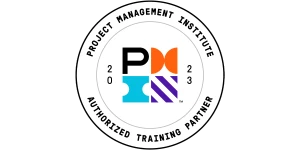Guide to Crafting a Winning Six Sigma Business Case
Did you know that a lack of clear goals is a primary reason for project failure?
A powerful Six Sigma business case is your first and best defense against this, turning abstract ideas into approved, funded, and successful projects.
This guide will move beyond simple definitions. We provide a step-by-step framework, real-world examples, and expert insights to help you craft a business case that not only explains your project but convinces stakeholders of its undeniable value.
Your Project’s Ultimate Goal: Profitability
A strong business case gets your project approved. A strategic business case ties that project directly to the company’s bottom line. Understand the high-level framework that connects process improvement to tangible financial gains.
You’re here because you need to justify a lean six sigma business case, and by the end of this article, you’ll have a clear roadmap and a downloadable template to build one that drives real results and demonstrates a clear path to lean six sigma and profitability.
Key Highlights
- Master a 7-step writing framework.
- Justify projects using financial data.
- Analyze real-world case study examples.
- Avoid common, project-killing mistakes.
- Secure buy-in from key stakeholders.
What is a Six Sigma Business Case? (And Why It’s Your Project’s Most Critical Document)
Before a single process is mapped or a data point is analyzed, every successful Six Sigma project begins with one foundational document: the business case.
Think of it as your project’s persuasive pitch. It’s a concise, data-driven argument that answers the most important question for any executive: “Why should we invest time and resources into this?”
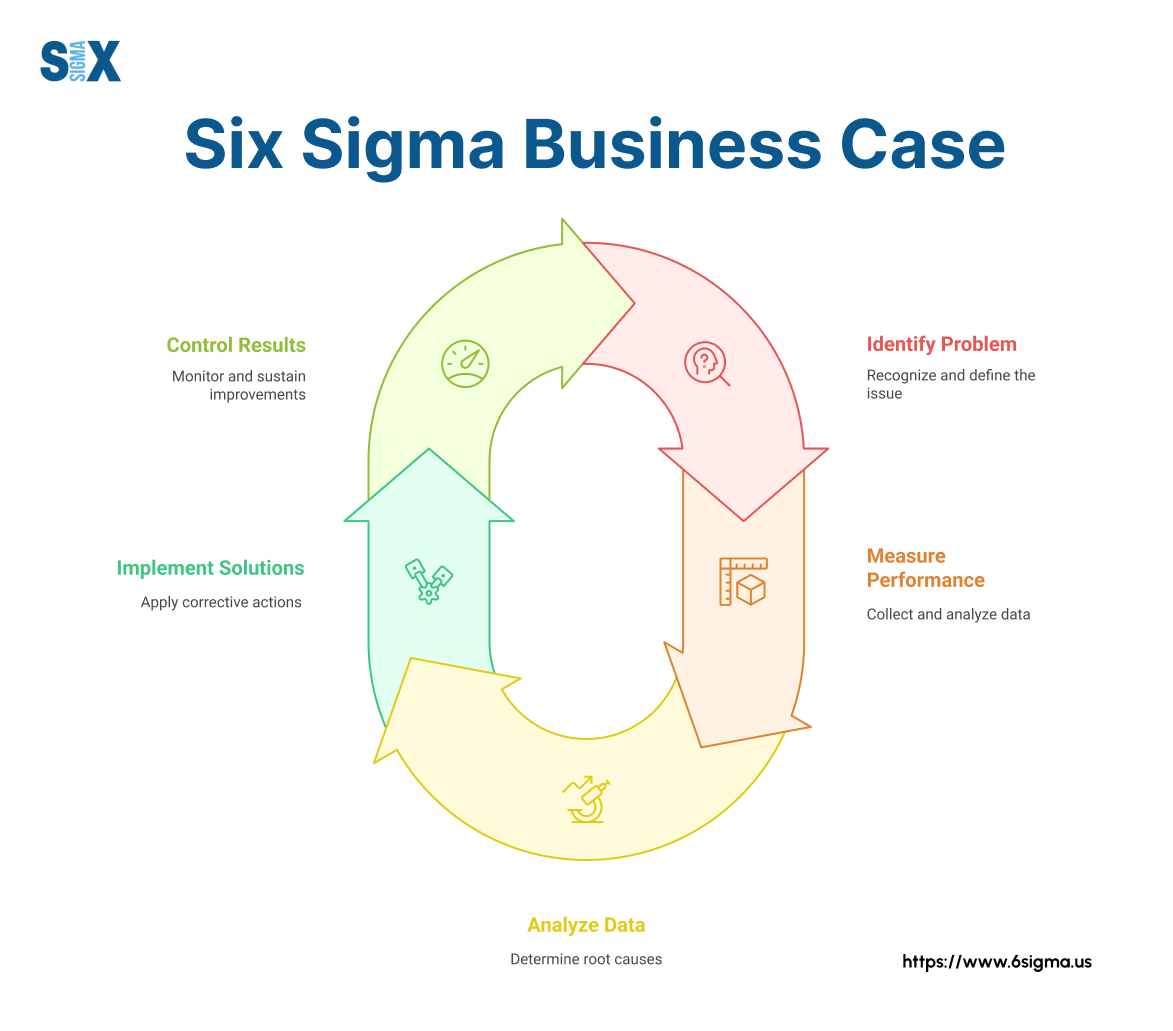
A Clear Definition: The Business Case vs. The Project Charter
While often used interchangeably, the business case and project charter serve distinct purposes.
The business case focuses entirely on the “Why.” It defines a business problem, quantifies its financial impact, and outlines the expected benefits of a solution.
In contrast, the project charter is the operational blueprint that answers the “How,” “Who,” and “When” after the business case has been approved.
For a clear project charter business case example, imagine a business case proves that customer support call times are 20% too long, costing the company $300,000 annually in wasted labor.
The project charter then details the specific team, a six-month timeline, and the budget required to fix it. To build that charter effectively, the team must first grasp the fundamentals, making a solid introduction to Lean an invaluable starting point.
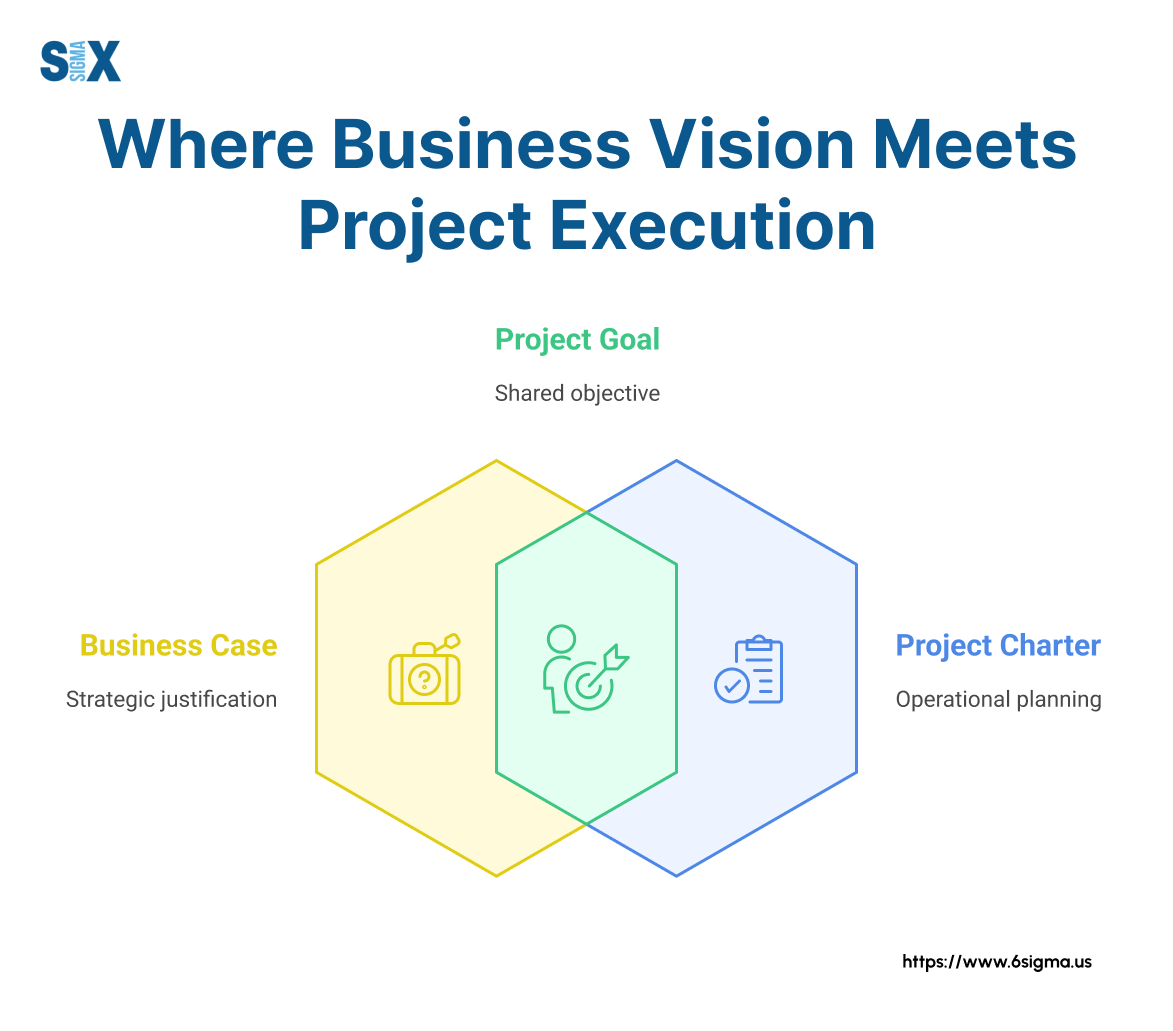
The “Cost of Inaction”: Why a Strong Business Case is Non-Negotiable
A powerful business case does more than just propose a solution; it highlights the “cost of inaction” It quantifies the money being lost, the customers being alienated, or the compliance risks being taken every day the problem goes unsolved.
This reframes your project not as a new expense on a balance sheet, but as a critical investment to stop a significant and ongoing financial drain.
By clearly showing what the status quo is costing the business, you create a sense of urgency that demands action.
Turn Cost-Cutting into a Profit Strategy
The next step is to build a systematic framework that not only plugs financial drains but actively drives new levels of profitability. Discover how Lean Six Sigma methodologies can be applied at a strategic level to transform your entire business.
The 7 Essential Steps to Write a Flawless Six Sigma Business Case
Now we move from the “what” to the “how“. Crafting a compelling business case is a systematic process.
By following these seven essential steps, you can build a logical, data-driven argument that is clear, concise, and difficult for leadership to reject. This section details exactly how to write a six sigma business case that gets approved.
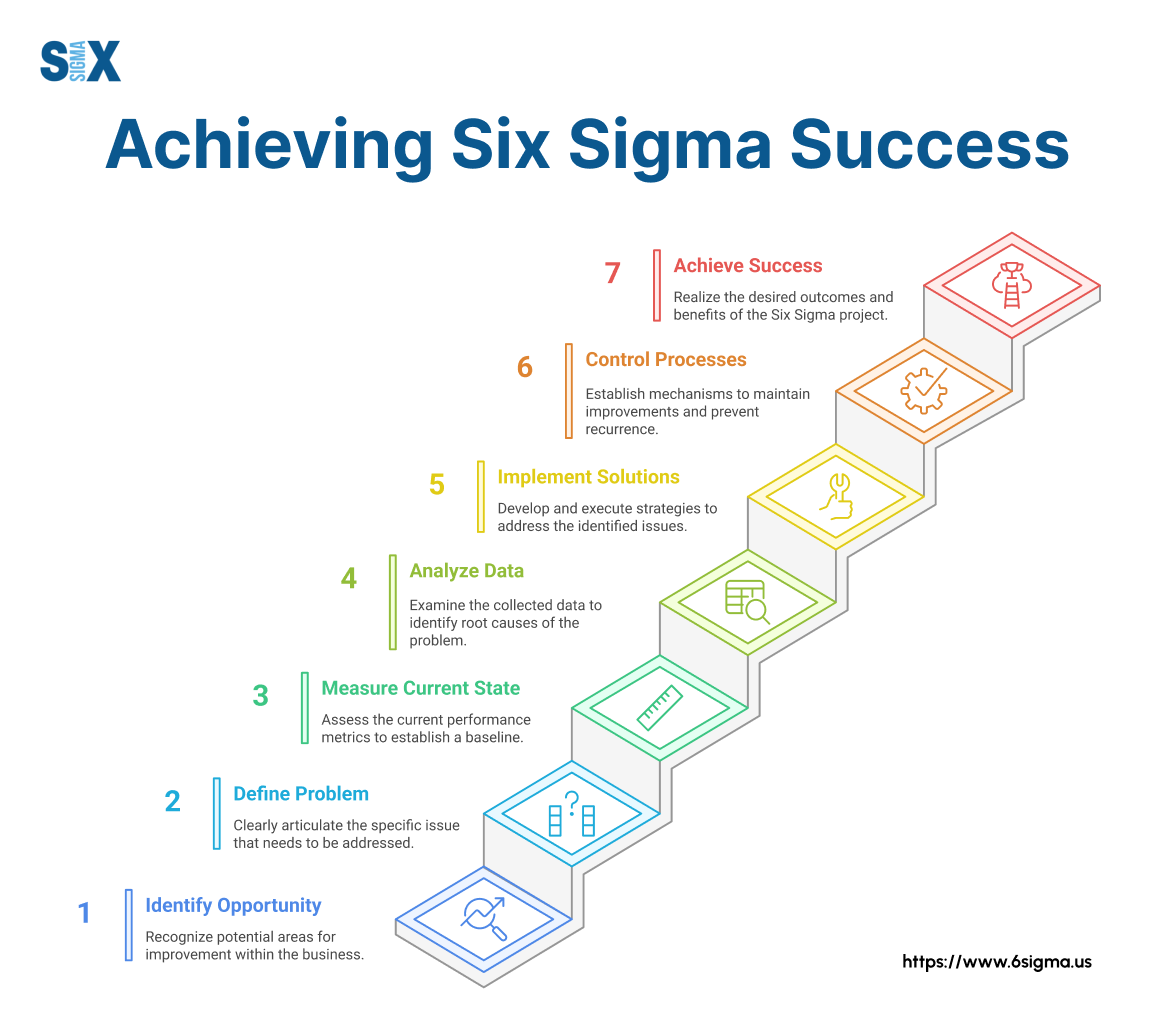
Step 1: The Business Problem Statement
This is the foundation of your entire case. Your problem statement must clearly and concisely articulate the pain the business is experiencing.
Avoid vague descriptions; instead, use hard data to define the magnitude of the problem.
- Vague: “Our customer onboarding process is too slow.”
- Data-Driven: “Our customer onboarding process currently takes an average of 14 business days, leading to a 12% client drop-off rate in the first month and directly impacting Q2 revenue goals.”
An effective problem statement gets to the heart of the issue. This often involves advanced root cause analysis methods to move beyond symptoms and identify the true source of the operational or financial pain.
Step 2: The Goal Statement (SMART Goals)
If the problem is the pain, the goal is the cure. Your goal statement must be SMART: Specific, Measurable, Achievable, Relevant, and Time-bound. This turns a wish into an actionable objective.
- Before (Vague): “We need to reduce shipping errors.”
- After (SMART): “We will reduce shipping errors from the current rate of 4.5% to below 1% within six months by implementing a barcode verification system. This project is relevant as it directly supports our strategic objective of improving customer satisfaction.”
Step 3: Project Scope (Defining the Boundaries)
Scope creep is the silent killer of projects. Clearly defining what your project will and will not address is crucial for managing expectations and resources.
| In-Scope (What we WILL do) | Out-of-Scope (What we WILL NOT do) |
|---|---|
| Analyze the packing process at the Dallas warehouse. | Change the shipping carrier selection process. |
| Implement a new QA checklist for packers. | Overhaul the entire inventory management software. |
| Train all Dallas warehouse packing staff. | Address order-taking processes in the sales department. |
Step 4: Financial Justification & ROI
This is where your project speaks the language of the C-suite: money. Quantify the expected benefits by calculating both hard and soft savings.
Hard savings are direct P&L impacts (e.g., reduced material waste), while soft savings are less direct but still valuable (e.g., improved employee morale). The key metric is Return on Investment (ROI).
Use the simple formula: ROI (%) = (Net Financial Gain / Cost of Project) x 100
Estimate Your Project’s ROI
Input your numbers below to see the ROI.
Make Your ROI a Reality
Our framework shows you how to connect individual projects to your company’s overarching financial goals, ensuring every improvement directly contributes to the bottom line.
Step 5: High-Level Project Timeline (The Roadmap)
You don’t need a detailed, day-by-day plan, but you do need a high-level roadmap. Outline the major project phases to show that you have a structured approach.
For most Six Sigma projects, this will follow the DMAIC (Define, Measure, Analyze, Improve, Control) framework.
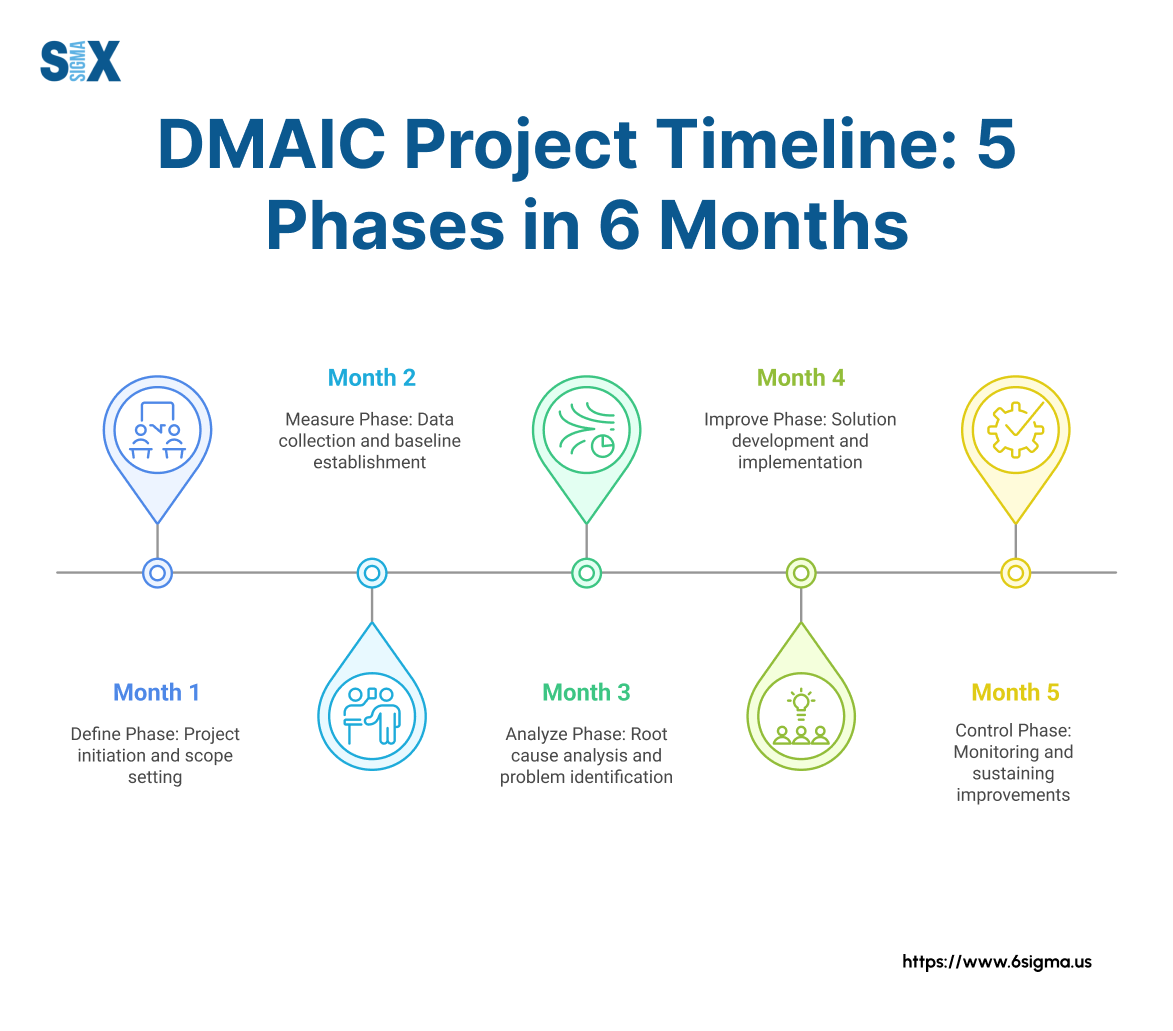
Step 6: Team Roles & Resources
Briefly identify the key people and skills needed for success. This includes the Project Sponsor (a leader who will champion the project), the Project Lead (the manager), and the core Team Members (the subject matter experts who will do the work).
The project will be led by a certified professional, and team members will be trained. Depending on the project’s complexity, the lead might hold a Six Sigma Green Belt certification, while oversight is provided by someone with a Six Sigma Black Belt certification.
For enterprise-wide strategic initiatives, a Six Sigma Master Black Belt certification is often required.
Team members contributing data may have a Six Sigma Yellow Belt certification, with all stakeholders understanding the basics via Six Sigma White Belt certification.

Step 7: Risk Assessment
Demonstrate foresight by identifying potential roadblocks. A simple risk assessment shows you’ve thought through potential challenges and have a plan to mitigate them.
Use a simple framework to categorize risks by their potential impact and likelihood.
- Example Risk: “Key team member from the IT department may be pulled onto a higher-priority project.”
- Mitigation Plan: “Secure commitment from the IT Director during the project approval phase and identify a backup IT resource.”
Beyond Theory: Real-World Six Sigma Business Case Study Examples
A well-structured business case is the launchpad for transformational projects.
To see how these documents translate into real-world results, let’s explore a six sigma case study example from two very different industries.
These case studies of six sigma demonstrate how a solid business case sets the stage for success, whether on a factory floor or in a hospital waiting room.
Six Sigma Case Study Example: Reducing Defects in Manufacturing
A mid-sized electronics manufacturer was facing a critical quality issue that threatened a key customer relationship. Their business case laid out the problem in stark terms.
- The Business Case:
- Problem: The final assembly line for their flagship product had a 15% defect rate, identified during final testing. This resulted in $50,000 per month in rework labor and scrapped materials.
- Goal: Reduce the final assembly defect rate from 15% to below 3% within six months, saving an estimated $400,000 annually.
With the business case approved, a Green Belt-led team launched a formal dmaic six sigma case study. In the Measure phase, they confirmed the 15% defect rate and identified that most failures occurred at two specific workstations.
During the Analyze phase, root cause analysis revealed that inconsistent torque on a key component and outdated soldering instructions were the primary culprits. In the Improve phase, the team introduced calibrated torque drivers and rolled out new, visual work instructions.
Finally, in the Control phase, they implemented new QA checklists and process control charts to ensure the gains were sustained.
The Result: After six months, the defect rate dropped to 2.1%, exceeding the goal and delivering an annualized saving of $460,000.
This six sigma case study in manufacturing began with a clear, financially-driven business case that secured the resources needed to solve a costly problem.
Lean Six Sigma Business Case Study: Streamlining Patient Intake in Healthcare
A regional health clinic was struggling with long wait times, leading to poor patient satisfaction scores and a stressful environment for staff.
Their challenge was less about product defects and more about process inefficiency.
- The Business Case:
- Problem: The average patient “door-to-doctor” time was 45 minutes, well above the industry benchmark of 20 minutes, contributing to a 10-point drop in patient satisfaction scores over the last year.
- Goal: Reduce the average door-to-doctor time to under 15 minutes within three months, improving patient flow and satisfaction.
This project was perfect for one of the most effective lean six sigma case studies: a hybrid approach. This strategy leverages the core principles of both methodologies, and to understand it better, it’s helpful to first grasp the fundamentals of Lean.
The team used Lean’s value stream mapping to visualize the entire patient intake process, identifying several non-value-added steps, including redundant paperwork and inefficient room allocation.
They then used Six Sigma’s data analysis to measure the time spent at each step, confirming that paperwork and room waiting were the biggest bottlenecks.
The Result: By digitizing part of the intake form and creating a new “fast-track” rooming protocol, the team reduced the average wait time to just 14 minutes in 10 weeks, and subsequent satisfaction surveys showed a 15-point improvement.
The Unspoken Truth: 5 Common Mistakes That Will Kill Your Business Case
Knowing what to do is only half the battle. Knowing what not to do can save your project from being rejected before it even starts.
Even the most promising ideas can be derailed by a poorly constructed business case. Avoid these five common, project-killing mistakes to ensure your proposal is robust, credible, and ready for approval.
- Vague Financials: This is the number one killer of business cases. If you can’t clearly connect your project to a financial outcome—cost savings, revenue generation, or risk mitigation—you’ve lost the argument. Leadership needs to see a return on investment. A statement like “improves efficiency” is meaningless without the data to back it up, such as “reduces processing time by 50%, saving $150,000 annually in labor costs.”
- Ignoring the “Voice of the Customer” (VoC): It’s easy to get focused on internal processes and forget who they ultimately serve. A project that improves an internal metric but has no positive impact on the end customer (or even a negative one) is a hard sell. Always frame your project’s benefits in terms of how they will improve the customer experience.
- Unrealistic Scope: Ambitious goals are good; trying to “boil the ocean” is not. A business case with a scope that is too large or complex will be seen as unmanageable and too risky. Break larger initiatives into smaller, phased projects with clear, achievable goals for each phase. This demonstrates a practical and grounded approach.
- Lack of Stakeholder Buy-in: Writing a business case in isolation is a recipe for failure. If key stakeholders from other departments (like IT, Finance, or Operations) see your proposal for the first time during the approval meeting, they may raise objections you weren’t prepared for. Socialize your idea and get input from these leaders before you finalize the document.
- Forgetting to Assess Risk: Presenting a plan with no mention of potential risks makes it seem naive and poorly thought out. Every project has risks. Acknowledging them and presenting a brief mitigation plan shows foresight and increases leadership’s confidence in your ability to manage the project successfully.
Consider the cautionary tale of “Project Efficiency-Now“. It was approved based on a weak business case with overly optimistic financial projections. Halfway through, leadership realized the data was flawed, and the promised ROI was impossible.
The project was abruptly canceled, wasting thousands of dollars and damaging the project lead’s political capital. A rigorous business case would have prevented this entirely.
From Document to Decision: How to “Sell” Your Business Case to Leadership
A perfect business case document is useless if it fails to persuade the decision-makers.
The final step is to “sell” your proposal. This isn’t about being a salesperson; it’s about being a strategic communicator who can translate a well-reasoned document into a compelling call to action.
Know Your Audience
Your presentation should not be one-size-fits-all. Tailor your message to the priorities of your audience. The Chief Financial Officer (CFO) will be most interested in the ROI, payback period, and impact on the P&L.
The Chief Operating Officer (COO), on the other hand, will care more about operational efficiency, throughput, and quality improvements. Speak their language and lead with the benefits that matter most to them.
Tell a Story with Data
Don’t just recite facts and figures from your document. Weave them into a simple, powerful narrative that is easy to follow and remember.
Structure your story logically:
- The Problem: “Here is the issue we are facing.”
- The Pain: “Here is how it is negatively impacting our customers and our bottom line.”
- The Plan: “And here is our clear, data-backed, low-risk plan to fix it.”
This narrative arc transforms a dry proposal into a compelling business opportunity.
Prepare for Objections
Expect questions. Tough questions are a sign of engagement, not rejection. Before you walk into the room, anticipate the likely objections.
What will they ask about the budget? The timeline? The required resources? The risks? Prepare clear, concise, and data-supported answers for each potential challenge.
This demonstrates that you are a credible and prepared leader who has thoroughly considered the project from all angles.
Presenting to leadership can be daunting. For complex projects, many organizations seek outside expertise to help refine and present their strategic initiatives.
Your Blueprint for Project Approval
Crafting a compelling Six Sigma business case is more than an administrative task—it’s the art of turning a problem into a funded, strategic opportunity.
By defining the problem, quantifying the financial impact, outlining a clear plan, and anticipating risks, you create a document that builds confidence and secures a “yes“.
You are now equipped with the steps, examples, and strategies to build a case that gets your projects off the ground and drives meaningful change within your organization.
Six Sigma Business Case FAQ
Here are quick answers to some of the most common questions about creating and using a Six Sigma business case.
Q. What is the business case in Six Sigma?
A concise, data-driven document that justifies the need for a Six Sigma project by defining a business problem, its financial impact, and the expected benefits of the proposed solution.
Q. What is a good Lean Six Sigma project?
A good project has a clearly defined problem, measurable data, a significant impact on cost, quality, or customer satisfaction, and a solution that is not already known.
Q. How is Six Sigma used in business?
Businesses use Six Sigma to systematically eliminate defects and variation in their processes, leading to lower costs, improved quality, and increased customer satisfaction. This data-driven approach is a cornerstone of achieving operational excellence and boosting lean six sigma and profitability.
Q. How does a business case fit into the overall project?
The business case is the very first step. It secures approval and funding. It then becomes the “north star” for the project charter and the subsequent DMAIC phases, ensuring the project stays on track to deliver its promised value.
SixSigma.us offers both Live Virtual classes as well as Online Self-Paced training. Most option includes access to the same great Master Black Belt instructors that teach our World Class in-person sessions. Sign-up today!
Virtual Classroom Training Programs Self-Paced Online Training Programs

